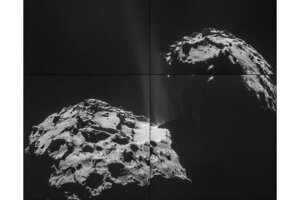European spacecraft catches comet belching
European Space Agency's Rosetta probe, which is currently circling Comet 67P/Churyumov-Gerasimenko, captured images of the comet ejecting gas and dust as it heats from the approaching sun.

An image taken by ESA's Rosetta probe on Sept. 26, 2014 shows jets of dust and gas escaping from the nucleus of Comet 67P/Churyumov-Gerasimenko.
ESA/Rosetta/NAVCAM
A European spacecraft's comet companion is starting to wake up as it gets closer and closer to the sun.
The European Space Agency's Rosetta probe, which arrived in orbit around Comet 67P/Churyumov-Gerasimenko in August after a 10-year deep-space chase, has photographed jets of gas and dust erupting from the icy wanderer's surface.
"The main talking point of this image is the spectacular region of activity at the neck of 67P/C-G," European Space Agency (ESA) officials wrote in a description of the photo, a four-image montage taken on Sept. 26 when Rosetta was 16 miles (26 kilometers) from the comet.
"What we’re seeing is the product of ices sublimating and gases escaping from inside the comet, carrying streams of dust out into space," they added. "As the comet gets progressively closer to the sun along its orbit, the surface will become warmer, and the level of activity will increase, producing a vast coma around the nucleus, along with a tail."
The $1.7 billion (1.3 billion euros) Rosetta mission launched in March 2004 and took a circuitous path through space, finally catching up to the 2.5-mile-wide (4 km) Comet 67P on Aug. 6 of this year. On that date, Rosetta became the first probe ever to orbit a comet.
The Rosetta team aims to make some more history soon. On Nov. 12, the probe will deploy a lander called Philae, which will spiral slowly down toward 67P and, if all goes according to plan, become the first robot to make a soft touchdown on a comet. Philae will snap photos and analyze samples of the comet.
Rosetta should continue studying 67P through at least December 2015, observing how the icy body changes as it approaches the sun. The mission's data should reveal a great deal about comet composition and, by extension, the early days of the solar system, mission team members say. (Comets are "time capsules" of material left over from the solar system's formation.)
Follow Mike Wall on Twitter @michaeldwall and Google+. Follow us @Spacedotcom, Facebook orGoogle+. Originally published on Space.com.
- Photos: Europe's Rosetta Comet Mission in Pictures
- Best Close Encounters of the Comet Kind
- Rosetta’s Long Road to Rendezvous With Its Comet | Video
Copyright 2014 SPACE.com, a TechMediaNetwork company. All rights reserved. This material may not be published, broadcast, rewritten or redistributed.

